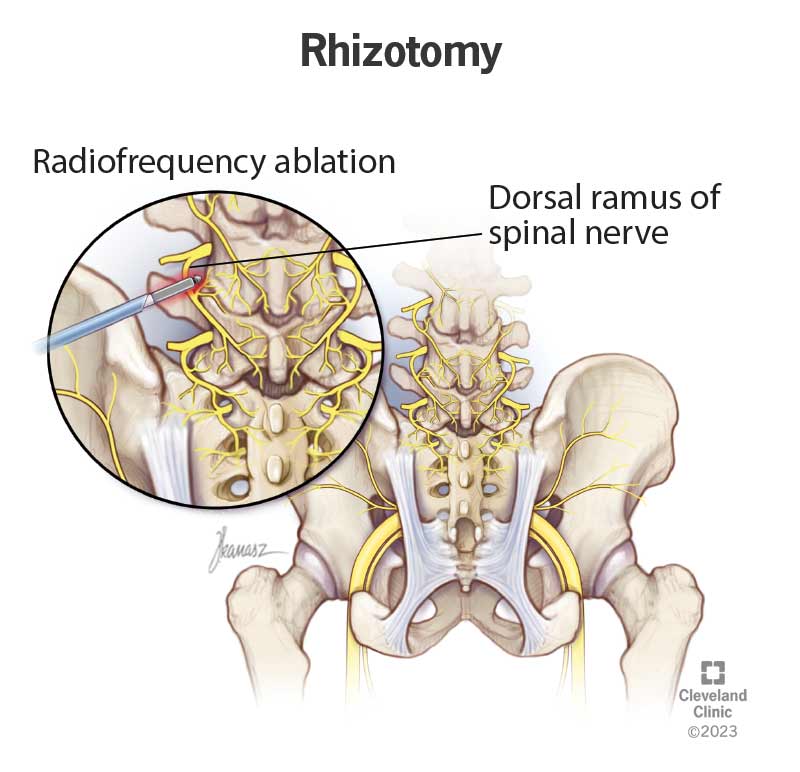A rhizotomy is a procedure that involves damaging certain nerves through surgical cutting, chemical ablation or radiofrequency ablation to treat chronic pain or spasticity. There are several different types of rhizotomies.
Advertisement
Cleveland Clinic is a non-profit academic medical center. Advertising on our site helps support our mission. We do not endorse non-Cleveland Clinic products or services. Policy

A rhizotomy is a procedure that involves damaging certain nerve fibers to help treat chronic pain or spasticity. Healthcare providers can destroy the nerves with any of the following methods:
Advertisement
Cleveland Clinic is a non-profit academic medical center. Advertising on our site helps support our mission. We do not endorse non-Cleveland Clinic products or services. Policy
Nerves are like cables that carry electrical signals between your brain and the rest of your body and vice versa. These signals help you feel sensations (like touch and pain) and move your muscles. They also maintain certain functions like breathing, sweating or digesting food.
In a rhizotomy, damaging problematic nerves prevents them from sending pain signals to your brain. This typically results in pain relief.
A nerve ablation and a rhizotomy have the same purpose: To damage nerve fibers that are causing pain or other issues. Rhizotomy is an umbrella term. Radiofrequency ablation (RFA) is a specific way of damaging the nerves using heat. Chemical ablation damages nerves using a substance that’s toxic to the nerves.
Neurotomy is another word healthcare providers may use in place of rhizotomy or nerve ablation.
Advertisement
In general, rhizotomies treat certain causes of chronic pain or spasticity. Many types of rhizotomies target different nerves to treat specific causes of pain.
Rhizotomies aren’t the first-choice treatment for chronic pain. Healthcare providers typically try more conservative treatments first, like physical therapy, NSAIDs or nerve blocks.
This rhizotomy targets nerves in your trigeminal ganglia, which are clusters of nerves on both sides of your face. It can help treat the following:
Providers may also call this a percutaneous rhizotomy. “Percutaneous” means “done through the skin.”
This rhizotomy targets the nerve roots that travel through the facet joints in your spine. It can help treat chronic pain (usually in your neck or lower back) due to conditions that affect your spine, such as arthritis and facet joint syndrome.
If the procedure is for nerves in your neck, providers may call it a cervical rhizotomy. If the procedure is for nerves in your lower back, they may call it a lumbar rhizotomy.
Healthcare providers sometimes use selective dorsal rhizotomy to treat spasticity in children with cerebral palsy. Spasticity is a disruption in muscle movement patterns that causes certain muscles to contract all at once when you try to move or even when you’re at rest.
This rhizotomy targets certain sensory nerve fibers in your lower spinal cord. Not every child with cerebral palsy is a candidate for this procedure.
Each type of rhizotomy has a different preparation process. Your healthcare team will let you know what you need to do. Don’t hesitate to ask questions.
In general, your healthcare team will likely recommend various tests to make sure the rhizotomy will be beneficial for you. These tests may include:
If you’ll have general anesthesia for the procedure, you’ll have an appointment with an anesthesiologist to ensure it’s safe for you. This may involve tests to check your heart’s health.
You may also need to stop taking certain medications, such as blood thinners (anticoagulants). Again, your provider will let you know if this applies to you. Never stop taking your medications unless your provider tells you to.
Advertisement
The process of a rhizotomy varies based on which nerves your healthcare provider is targeting and what kind of rhizotomy it is — surgical cutting, radiofrequency ablation or chemical ablation.
In general, a rhizotomy may involve the following aspects:
Advertisement
The majority of people who have a rhizotomy experience long-lasting pain relief or significant improvement in spasticity. However, some people experience little to no pain relief.
Your healthcare team can provide more information about the likelihood of success for your specific procedure.
Risks and complications for a rhizotomy vary depending on the kind of procedure as well as which nerves your healthcare provider treats. Providers expect certain sided effects and don’t call them complications. For example, you can lose facial sensation after a trigeminal rhizotomy. Your provider will go over all of the possible risks and complications before your procedure.
In general, you may experience soreness, bruising or minor bleeding at the site of the rhizotomy injection or incision. This is usually mild and goes away within a few days. In rare cases, an infection can develop at the site of the rhizotomy.
If you notice any signs of post-procedure complications, such as infection at the incision site or nerve issues like weakness or burning pain, call your healthcare provider right away.
A rhizotomy may help treat several causes of chronic pain. Healthcare providers usually reserve rhizotomies as a last option for pain treatment if other methods, such as pain medication and physical therapy, haven’t been successful. A rhizotomy is helpful for many people who decide to have the procedure — but not everyone. Talk with your provider to see if a rhizotomy is right for you.
Advertisement
Spasticity causes your muscles to contract all at once, making daily tasks painful. Cleveland Clinic experts can help relieve the pain and get your muscles moving.

Last reviewed on 04/14/2023.
Learn more about the Health Library and our editorial process.